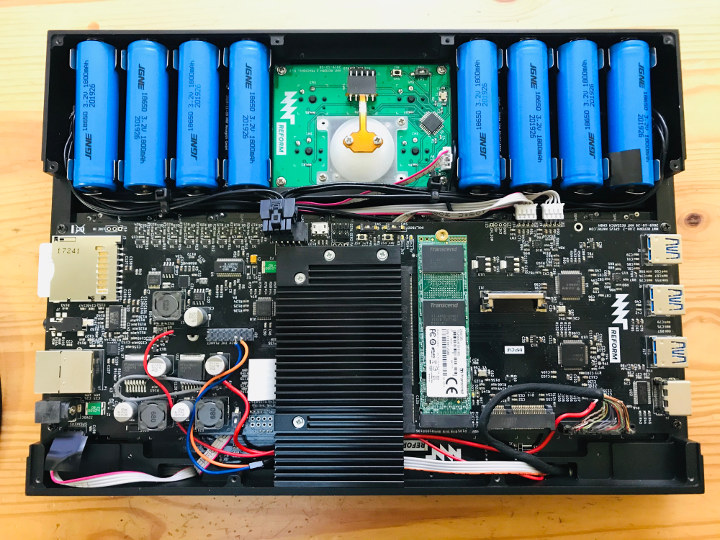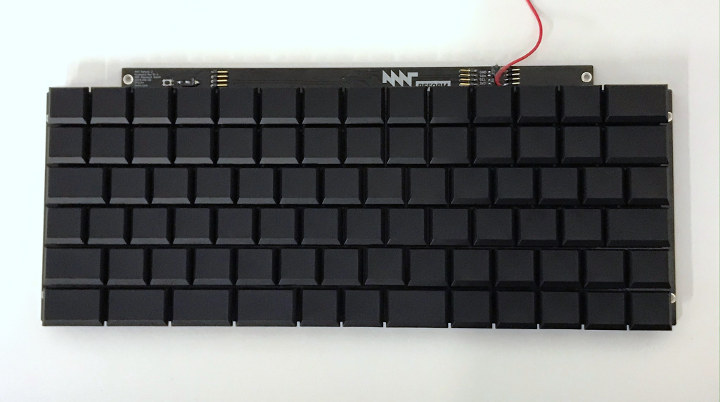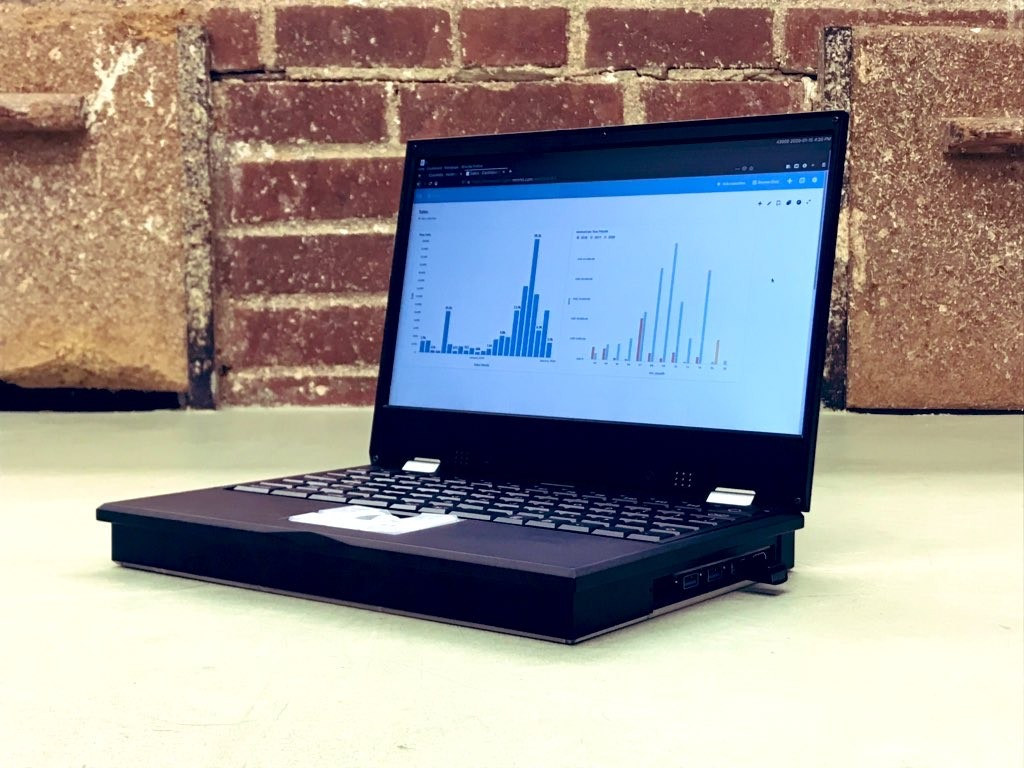We first covered MNT Reform in fall of 2017, when it was a prototype for a DIY and modular laptop powered by NXP i.MX 6QuadPlus processor, and with plans to eventually use i.MX 8 hexa-core processor.
Last year they designed several beta units of Reform to get feedback for a dozen users, and have now fully redesigned the laptop based on an NXP i.MX 8M system-on-module with the crowdfunding campaign expected to go live in February on Crowd Supply.
MNT Reform 2 specifications:
- SoM – Boundary Devices Nitrogen8M SOM with
- SoC – NXP i.MX 8MQuad quad-core Cortex-A53 processor @ 1.5 GHz, 1x Arm Cortex-M4F real-time core Vivante GC7000Lite 3D GPU
- System Memory – 4GB LPDDR4
- Storage – Probably none
- Networking – Atheros Ethernet MAC chip (AR8035)
- 200 pin SO-DIMM edge connector exposing USB 3.0, PCIe, MIPI DSI, etc…
- Dimensions – 67.6mm x 48.4mm
- Motherboard
- Storage – SD card slot, M.2 SSD support
- Video Output
- Texas Instruments SN65DSI86 MIPI DSI to eDP controller for the display
- HDMI output up to 4K
- Audio – Wolfson/Cirrus WM8731 audio DAC; headphone/microphone jack; amplifier driving two 1W speakers
- Networking – Gigabit Ethernet (RJ45)
- USB – Texas Instruments TUSB8041 USB 3.0 hub chip for the trackpad, keyboard, and three USB Type-A ports
- Expansion Slots
- M.2 M-key slot for NVMe SSD
- mPCIe slot for WiFi card, an embedded graphics card, FPGA board, etc..
- System Controller – NXP LPC11U24 Cortex-M0 MCU to control an analog monitor chip for the 8 battery cells and the charger.
- Power Supply – Via barrel jack
- Displays
- 12.5″ IPS eDP (embedded DisplayPort) panel from Innolux, with 24-bit color and 1920×1080 resolution.
- 128×32 pixel OLED display on top of the keyboard
- User Input
- Keyboard – ANSI layout with 80 mechanical low-profile Kailh Choc switches
- Trackball – 5 buttons and a small surface tracking sensor
- Optional trackpad as an alternative to the trackball
- Batteries – Replaceable 8x 18650 LiFePO4 battery cells with a nominal voltage of 3.2V (meaning an operating voltage of 28.8V).
- Case parts
- Screen Back for housing the display and upper half of hinges.
- Screen Front for housing speakers and providing display bezel.
- Main Box for all boards, keyboard, battery board…
- Main Box Top to provide a bezel for the keyboard and the system controller OLED.
- Main Box Bottom either milled from clear acrylic or aluminum.
- Certifications (Planned/Looked into) – OSHWA (Open Source Hardware Association), DIN SPEC 3105 Open Hardware Standard, Fairtronics (for environmental impact)

The goals of the project are to provide an open-source hardware laptop that avoids binary blobs as much as possible and is environmentally friendly. These goals guided many of the technical decisions.
For example, there are many NXP i.MX 8M SoM’s, but MNT selected Nitrogen8M as the schematics are available after registration on Boundary Devices website, and that means people wanting to create their own module compatible with Reform 2 could do so.
They also decided to use the MIPI DSI interface instead of HDMI for the internal display because HDCP requires a binary blob, and instead they went with a MIPI DSI to eDP controller that is supported in mainline Linux. The Vivante GPU will also rely on Etnaviv open-source graphics driver.
The laptop must also be user-serviceable with easy to source and replaceable battery, and MNT Reform 2 can now be fully assembled by the end-user in less than 30 minutes compared to nearly one day for the first prototype. The design only relies on standard M2 and M4 screws.
You’ll find the source code for the software and firmware, mechanical files, as well as KiCAD design files for all boards on the company’s git repository.

While the crowdfunding campaign has yet to start, and pricing is not determined, those are the options that one should expect (from lowest to highest price):
- Motherboard only with Nitrogen8M SoM and power adapter.
- Caseless Reform DIY Kit with all PCBAs, Nitrogen8M SoM, hinges. Trackball or trackpad module, disassembled, keycaps blank or labeled (QWERTY), speakers, display panel, set of batteries, set of screws, SD Card with bootable Debian GNU/Linux, power adapter, and user manual. You’d have to print or mill your own case from provided 3D files
- Reform DIY Kit – same as above plus all case parts
- Reform Laptop – Fully assembled, plug-and-play device with a power adapter, printed manual, and custom soft-shell sleeve.
- Reform Laptop Max – Reform Laptop plus built-in 1TB SSD and WiFi-card.
MNT Reform 2 is not the first DIY Arm Linux laptop as the Freescale i.MX 6 based Novena laptop was introduced in 2014, and the more affordable Allwinner A64 powered Olimex Teres-I in 2017. More recently, Pine64 launched Pinebook Pro Arm Linux laptop with an attractive price tag of $200 despite featuring a fairly powerful Rockchip RK3399 processor, but admittedly with less of a focus on getting everything open-source and modular.

Jean-Luc started CNX Software in 2010 as a part-time endeavor, before quitting his job as a software engineering manager, and starting to write daily news, and reviews full time later in 2011.
Support CNX Software! Donate via cryptocurrencies, become a Patron on Patreon, or purchase goods on Amazon or Aliexpress






Well, hello, 2001.
Haven’t seen laptops this thick for over 2 decades.
Also, A53 does not belong in a laptop of any kind in 2020.
Hi Benjamin,
Thanks for taking the time to provide your valuable feedback. Both the thickness of the device and the choice of processor are intentional trade-offs:
– In a device that focuses on openness, we believe that it’s more important to have an extremely serviceable architecture, opposed to the trend of thinness at any cost. Also, Reform has a mechanical keyboard, which naturally requires more space.
– While it’s not a performance beast, the i.MX8M is capable of running most productivity applications and browsers just fine, it has 6000 pages of detailed documentation, and all drivers for it are already in mainline Linux (-next). Again, take a moment to understand the big picture of what we’re trying to achieve: finding the best trade-off between openness and usability. Also, the processor is on a pluggable module that can be upgraded in the future.
Best
Lukas
There are not that many newer chips out there. Unfortunately. I guess that is the main issue why they picked an A53.
Replaceable battery cells: A dream comes true.
too bad they opted for a less common LiFePO4 chemistry. A regular li-ion cell, those you can find in pretty much any old laptop and most of the times, they are still usable, even if the whole pack is not.
Before manufacturers used battery managements, that would brick themselfs when cells died, you could replace the cells if you wanted to.
Hi Benjamin,
Thanks for commenting on this issue as well. I’m not sure if I’m understanding your point here, though. Would you prefer to use second-hand Li-Ion battery cells instead of LiFePO4 cells that are safer and have more charge cycles?
Best
Lukas
True, that’s a good point. I recycle batteries when I can. Have a bunch of them here. Most of them are regular Li-Ion.
I still don’t understand why companies are not using replaceable batteries. As you can see, it is not that complicated. You could also do it in Akku packs. But I guess: Everything has to be flat. I typed on the newer Ultrabooks and on the new Apple Notebooks. Horrible. No feedback at all. I got my old X220 and I am really happy with this design. Hope to see more Notebooks in the future with this kind of design. 🙂
the easy reason is planned obsolescence and cost. It costs more to design a product with replaceable battery in mind.
I suspect they used LiFePO4 for improved safety or at least to reassure those afraid of classical Li-ion. But I agree that it’s bad, the energy density is much lower, they main benefit usually is to better stand deep discharges and to deliver higher peak power, two characteristics that a laptop doesn’t need.
association of brand name with fire events is an large disaster.
lifepo4 reduce the volumetric density to 3/4 and reuse old li-ion cell need to find same internal resistance and same capacity with is not “old cell” compatible
liion cycle only 500.
lipofe4 can cycle upto 2000.
a collect center with automatic sorting machine in each big city, can catch our old cells and return an old new pack
li-ion can easily last couple of 1000s of cycles, if you cycle them in the 20-70% range.
yes 50% unused capacity (like electricle vehicule) but in this case lifepo4 can cycle 4000 easy
>mechanical switches
yes
>easily repairable
Yes
>lots of ports
YES
>trackball
YES!
>replaces capslock with ctrl
YESS!
>open source
YESSS!!!
>1000$
pricey but of quality
>1.5ghz and 4gigs of ram
NOOOOOOOOOO,so close yet so far